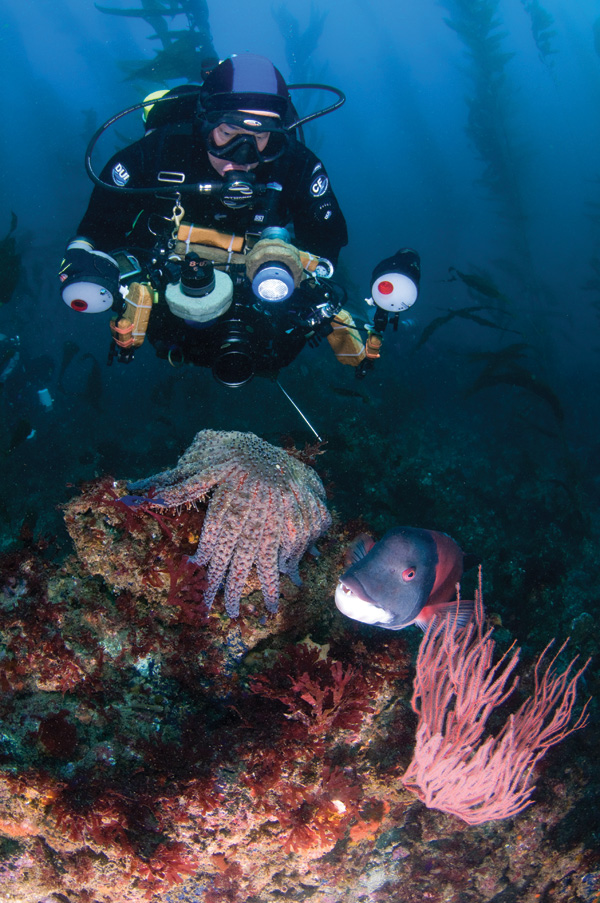The Channel Islands National Park resides off the Southern California coast, ranging from the western tip of San Miguel Island to the east end of Anacapa. The park encompasses nearly 250,000 acres above and below, and is made up of four individual islands in the upper channel island chain – San Miguel, Santa Rosa, Santa Cruz and Anacapa. There are also four other channel islands in the lower chain, but they are not included in the National Park System.

The Channel Islands are one of my favorite places in the world to dive. Very few places capture the essence of California diving as well as the Channel Islands do. San Miguel sits outside of the California bite, unprotected and fully exposed to the unpredictable power of the Pacific Northwest. The island is battered with regularity by strong wind and massive waves.
San Miguel is also located very close to Point Conception – the scientifically designated North/South Faunal divide. Your chances of seeing a greater diversity of animals here are much better then anywhere else in Northern or Southern California. Wolf eels (wolf fish) Giant Ling Cod, massive Rock Fish, Gunnels, Pricklebacks, Nudibranchs, Warbonnet’s and much more can all be found in the waters surrounding Miguel. The remoteness of the island and the stories about the “resident landlord” as told by urchin divers add to the mystique that surrounds Miguel.

For me, Miguel has been one of those places that Neptune has kept beyond my reach. My first three attempts to get here were stymied and we were diverted to other islands. So when my buddy asked if I wanted to join them on a run to San Miguel, naturally I couldn’t resist.
With the early morning sun low in the sky, I figured I would shoot macro for the first dive. And is was a good thing I did, as we find a massive Nudibranch known as a Dirona albolineata feeding on hydroids. This is a perfect subject too, with pearl white cerata and an alabaster white trim – it was absolutely stunning.
Suddenly, my buddy signals me pointing at his camera housing, and I think for a second he is having camera issues. Then I notice something moving around the strobe arms – a tiny Penpoint Gunnel, gold in appearance with a white stripe across its face. The Gunnel looks more like a tiny eel then a fish. We never see these further South and this is a first for me. If you look closely in the accompanying photo, you can see the viewing window on the top of my buddy’s housing under the tiny little Gunnel. I fired two shots off and he darted away, never to be found again.
With the macro opportunities so plentiful I continue to put off the wide stuff until later.
Completing our fourth dive for the day, we relax and settle in for a while. Anticipating a great dinner as we head east towards our night dive spot at the east end of Miguel.
The crew sets us up on the east tip of Miguel for our night dive. I’m excited as I have never made a night dive at any of the Northern Channel Islands, and once again we are not disappointed. Tiny Pricklebacks and an Aeolidia papillosa – another rarely seen Nudibranch – were waiting for us below. The visibility on the night dive was incredible, the cast of the light beams glancing off of the distant kelp really had my heart racing.
The next morning I promise myself: its wide-angle or nothing. We head for Santa Cruz to a spot called Gull Island. Gull Island is known above all for its Purple Hydrocoral, California’s only known hard coral, found here in shallow waters. The captain puts us on the northwestern end of this little spit of land. The viz from the boat looks incredible, the sun is rich and the kelp is standing straight up, so armed with my Tokina 10-17 I enter the water. The first order of Business – find the coral. After what seemed like a total snipe hunt we finally came across a few loose patches.
 The reef bottoms-out here at 70 feet with large rocky outcroppings crowned with the Hydrocoral. Big luscious seafans, gorgonians and great kelp density combine for some really incredible opportunities.
The reef bottoms-out here at 70 feet with large rocky outcroppings crowned with the Hydrocoral. Big luscious seafans, gorgonians and great kelp density combine for some really incredible opportunities.
After three failed attempts to dive Miguel I must say, I am extremely happy we made it this time. The marine life was everything I had expected it to be and more – I just hope it doesn’t take me another three attempts to make it back. We made nine dives in two days, everyone ate like royalty and we were treated to some of the finest California diving there is. Needless to say, the macro work the wide angle opportunities here are incredible as well.
When booking a trip to this area, remember, the best of California’s diving is done during the Fall months. October and November are prime time for wide angle shooting. The water is still relatively warm and crispy clean. San Miguel is accessible from ports in Ventura and Santa Barbara. Hunting may be allowed but check with your chosen charter boat to see if you will be heading to a reserve or not.
—————————————————————————————–
Story and Photos by Mike Bartick
Check out more of his photography at www.saltwaterphoto.com
—————————————————————————————–
